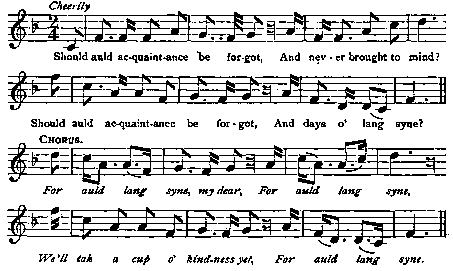Шотладская песня (Бернс/Смирнов)
| Шотладская песня , пер. Д. Смирнов-Садовский (р. 1948) |
| Язык оригинала: шотландский. Название в оригинале: A Scottish Song. — Опубл.: 1795 (перевод). Источник: http://www.robertburns.org/works/537.shtml |
1795.
Перевод: 19 октября 2009, Сент-Олбанс. |
1795
|
Примечания
Песня посвящена другу Бернса Александру Каннингэму, эдинбургскому юристу, который в 1788 ухаживал за девушкой по имени Анн Стюарт, но та предпочла ему эдинбургского врача Форреста Дьюэра. Эта или подобная история легла в основу песни. Бернс просил композитора Стивена Кларка, снабдить текст мелодией, но из этого ничего не вышло, и песня осталась без музыки. Томсон получил текст от автора в августе 1795 году и опубликовал в «Шотландских мелодиях» в 1799 году под названием «Безнадежный влюблённый», подтекстовав её под старинную мелодию «Былые времена» (“Auld lang syne”) - одну из самых популярных шотландских песен.
Мелодия (выбранная Томсоном после смерти Бернса):
________________________________________ Notes to the poem:
This song was written to soothe the feelings of his friend, Mr. Alexander Cunningham, solicitor, who, as mentioned in the note toHad I A Cave, had been cruelly jilted by a lady to whom he was much attached.
Page 363. I. LOVE-SONGS : PERSONAL
No. 34. Now Spring has clad the grove in green. Thomson's Scotish Airs, 1799, pi. 'Written for this work by Robert Burns.' The MS. is in the Thomson Collection. This address of condolement with Alexander Cunningham is on the same subject as the preceding song. Burns intended Stephen Clarke to compose for the verses, but nothing came of it, and the song has no original melody. Thomson obtained a copy of the verses in the beginning of August, 1795, and published them with, the old tune of Auld lang syne, disguised under a new title, The hopeless lover, which he lifted bodily from the Scots Musical Museum. There is no doubt about the source, because Johnson's setting of the tune is considerably different from all previous copies. Thomson did precisely the same thing with the popular tune, O, can ye labour lea for Burns's Auld lang syne. Source: «traditionalmusic.co.uk»
Cunningham, Alexander (d 1812)
A nephew of Principal William Robertson, the historian, Alexander Cunningham was the eldest son of James Cunningham of Hyndhope. When Burns arrived in Edinburgh, Cunningham was practising law. It is not known exactly when or where they met, but it may well have been at a meeting of the Crochallan Fencibles. Cunningham's chambers were in St James's Square, where the poet lodged for a time with William Cruikshank, so the neighbourly proximity may equally possibly have given rise to the friendship.
Before he met Burns, Cunningham had been wooing Anne the daughter of John Stewart of East Craigs. Writing from Ellisland on 27th July 1788, Burns enclosed some verses asking:
"And is thy ardour still the same? |
Volcano or no, Anne Stewart turned down Cunningham in favour of an Edinburgh surgeon, Forrest Dewar, to whom she bore a son and three daughters. On 24th January 1789, Burns wrote to console his friend: 'When I saw in my last Newspaper that a Surgeon in Edinb was married to a certain amiable and accomplished young lady whose name begins with, Ann; a lady with whom I fancy I have the honour of being a little acquainted, I sincerely felt for a worthy much-esteemed friend of mine. As you are the single only instance that ever came within the sphere of my observation of human nature, of a young fellow, dissipated but not debauched, a circumstance that has ever given me the highest idea of the native qualities of your heart, I am certain that a disappointment in the tender passion must, to you, be a very serious matter….etc
© D. Smirnov-Sadovsky. Translation. Can be reproduced if non commercial. / © Д. Смирнов-Садовский. Перевод. Комментарий
| Это произведение опубликовано на Wikilivres.ru под лицензией Creative Commons |

